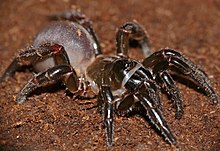Ctenizidae
| Ctenizidae Temporal range:
| |
|---|---|

| |
| Cteniza sauvagesi | |
| Scientific classification | |
| Domain: | Eukaryota |
| Kingdom: | Animalia |
| Phylum: | Arthropoda |
| Subphylum: | Chelicerata |
| Class: | Arachnida |
| Order: | Araneae |
| Infraorder: | Mygalomorphae |
| Clade: | Avicularioidea |
| Family: | Ctenizidae Thorell, 1887 |
| Genera | |
|
See text | |
| Diversity[1] | |
| 2 genera, 5 species | |
Ctenizidae (/ˈtənɪzədiː/ tə-NIZZ-ə-dee)[2] is a small family of mygalomorph spiders that construct burrows with a cork-like trapdoor made of soil, vegetation, and silk. They may be called trapdoor spiders, as are other, similar species, such as those of the families Liphistiidae, Barychelidae, and Cyrtaucheniidae, and some species in the Idiopidae and Nemesiidae. The name comes from the distinctive behavior of the spiders to construct trapdoors, and ambush prey from beneath them.[3]
In 2018, the family Halonoproctidae was split off from the Ctenizidae.[4] A further genus, Stasimopus, was split off into its own family, Stasimopidae, in 2020.[4][5] The family currently consists of two genera and five species.[1]
Etymology
The name derives from Greek κτενὶζειν ktenizein, meaning "combing" or "cleaning", referring to their behaviour of cleaning continuously, and the suffix "-idae", which designates belonging to a family.[citation needed]
Taxonomy
The family Ctenizidae was first described by Thorell in 1887, being based on the genus Cteniza.[4] Since the advent of molecular phylogenetics and its application to spiders, the family has been progressively dismantled;[6] the World Spider Catalog lists over 100 genera formerly placed in Ctenizidae but now transferred to other families.[4] The Halonoproctidae were split off in 2018, leaving only three genera. Even so, the family was not monophyletic, since Stasimopus is not in the same clade as the other two genera, according to a 2018 study (the three genera left in the Ctenizidae at that time are shaded in yellow):[6]
| |||||||||||||||||||||||||||||||
In 2020, a large scale molecular phylogenetic study confirmed the placement of Stasimopus outside the clade consisting of Cteniza and Cyrtocarenum, and transferred it to its own family, Stasimopidae.[5] This placement is accepted by the World Spider Catalog as of February 2022[update].[4]
Genera
As of February 2022[update], the World Spider Catalog accepted only two extant genera:[4]
- Cteniza Latreille, 1829 — Europe, Central Asia
- Cyrtocarenum Ausserer, 1871 — Greece, Turkey
- Extinct genera
- †Baltocteniza Eskov & Zonstein, 2000 Early Eocene Baltic amber[7]
- †Electrocteniza Eskov & Zonstein, 2000 Early Eocene Baltic amber[7]
Distribution and habitat
The two genera of Ctenizidae are found in Europe and Turkey, particularly in France and Italy.[4] Like many other mygalomorphs, Cteniza have highly localized distributions. This results in clumps of spider burrows a short distance from their maternal burrows, resulting in a dense cluster of spiders surrounding a large female.[8]
See also
References
- ^ a b "Currently valid spider genera and species", World Spider Catalog, Natural History Museum Bern, retrieved 2022-02-16
- ^ "Ctenizidae". Merriam Webster. Retrieved October 30, 2024.
- ^ Buchli, Harro H.R. (1969-02-01). "Hunting Behavior in the Ctenizidae". American Zoologist. 9 (1): 175–193. doi:10.1093/icb/9.1.175. ISSN 0003-1569.
- ^ a b c d e f g "Family Ctenizidae Thorell, 1887", World Spider Catalog, Natural History Museum Bern, retrieved 2018-05-24
- ^ a b Opatova, V.; Hamilton, C.A.; Hedin, M.; Montes de Oca, L.; Král, J. & Bond, J.E. (2020). "Phylogenetic systematics and evolution of the spider infraorder Mygalomorphae using genomic scale data". Systematic Biology. 69 (4): 671–707. doi:10.1093/sysbio/syz064. PMID 31841157.
- ^ a b Godwin, Rebecca L.; Opatova, Vera; Garrison, Nicole L.; Hamilton, Chris A. & Bond, Jason E. (2018-09-01), "Phylogeny of a cosmopolitan family of morphologically conserved trapdoor spiders (Mygalomorphae, Ctenizidae) using Anchored Hybrid Enrichment, with a description of the family, Halonoproctidae Pocock 1901", Molecular Phylogenetics and Evolution, 126: 303–313, doi:10.1016/j.ympev.2018.04.008, PMID 29656103, S2CID 4890400
- ^ a b Eskov, K. Y.; Zonstein, S. L. (2000). "The First Ctenizoid Mygalomorph Spiders from Eocene Baltic Amber (Araneida: Mygalomorphae: Ctenizidae)". Paleontological Journal. 34 (suppl. 3): S268 – S274. Part 1; Part 2 (PDF).
- ^ Hormiga, Gustavo; Jäger, Peter; Jocqué, Rudy; Platnic, Norman I.; Ramírez, Martín J.; Raven, Robert J. (2020). Spiders of the World: A Natural History. Princeton University Press. pp. 18–53. ISBN 978-0-691-18885-0. JSTOR j.ctvpbnqfg.
Further reading
- Raven, R.J. 1985 The spider Infraorder Mygalomorphae (Araneae): cladistics and systematics. Bulletin of the American Museum of Natural History 182: 1-180.
- Murphy, Frances & Murphy, John (2000): An Introduction to the Spiders of South East Asia. Malaysian Nature Society, Kuala Lumpur.
- Tso, I.; Haupt, J. & Zhu, M. (2003): The trapdoor spider family Ctenizidae (Arachnida: Araneae) from Taiwan. The Raffles Bulletin of Zoology 51(1): 25-33. PDF Archived 2007-06-17 at the Wayback Machine (Ummidia and Latouchia)